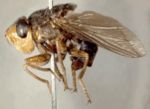Difference between revisions of "Dermatobia hominis"
| (11 intermediate revisions by 3 users not shown) | |||
| Line 1: | Line 1: | ||
| − | {{ | + | {{unfinished}} |
| − | |||
| − | |||
| − | |||
| − | |||
| − | |||
| − | |||
| − | |||
| − | |||
| − | |||
| − | |||
| − | |||
| − | |||
| − | }} | ||
[[Image:Human Bot fly.jpg|thumb|right|150px|''Human Bot Fly'' <br> J. Eibl 2007, WikiMedia Commons ]] | [[Image:Human Bot fly.jpg|thumb|right|150px|''Human Bot Fly'' <br> J. Eibl 2007, WikiMedia Commons ]] | ||
[[Image:Human Bot fly Larvae.jpg|thumb|right|150px|''Human Bot Fly Larvae'' - Captain R. Goodman 2007, WikiMedia Commons]] | [[Image:Human Bot fly Larvae.jpg|thumb|right|150px|''Human Bot Fly Larvae'' - Captain R. Goodman 2007, WikiMedia Commons]] | ||
| − | Also known as: | + | |
| + | |||
| + | {| cellpadding="10" cellspacing="0" border="1" | ||
| + | | Also known as: | ||
| + | | '''Human bot fly | ||
| + | <br> | ||
| + | '''Torsalo | ||
| + | <br> | ||
| + | '''Berne | ||
| + | <br> | ||
| + | '''Ura | ||
| + | |- | ||
| + | |} | ||
| + | |||
| + | ===Scientific Classification=== | ||
| + | |||
| + | {| cellpadding="10" cellspacing="0" border="1" | ||
| + | | Class | ||
| + | | Insecta | ||
| + | |- | ||
| + | | Order | ||
| + | | Diptera | ||
| + | |- | ||
| + | | Family | ||
| + | | Oestridae | ||
| + | |} | ||
==Hosts== | ==Hosts== | ||
| Line 22: | Line 34: | ||
==Identification== | ==Identification== | ||
| − | The mature larvae may grow up to 25mm in length. ''D. hominis'' are similar to [[Calliphoridae|''Calliphora'']] in appearance | + | The mature larvae may grow up to 25mm in length. ''D. hominis'' are similar to [[Calliphoridae|''Calliphora'']] in appearance. They have a blue-black abdomen, and have yellow-orange head and legs. |
| + | |||
| + | Larvae are distinctive as they taper towards the posterior end | ||
| − | |||
==Life cycle== | ==Life cycle== | ||
| − | The adults do not feed, and draw food from the larvae | + | The adults do not feed, and draw food from the larvae, which accumulate stores throughout their developmental stage. The female then catches an insect, most commonly the mosquito, and lays a batch of eggs on it. |
| + | |||
| + | The insect lands on a host, and the L1 larvae then hatch on the host, and quickly penetrate the skin. They then undergo a transformation to L2, and then subsequently to L3. The larve fully mature, and the move to the ground to pupate. Then then emerge later as adults. | ||
| + | |||
| + | *Eggs laid on blood sucking flies such as mosquitoes | ||
| + | **These hatch when the mosquito next lands on a warm blooded animal | ||
| − | + | *Larvae penetrate skin causing painful swellings | |
| − | + | *Larvae emerge after 35-42 days and fall to ground to pupate | |
| − | + | *'''4 month''' life cycle | |
| − | |||
| − | |||
| − | |||
| − | |||
| − | + | '''Pathogenesis''' | |
| + | *In humans, the larvae are most often found in swellings on the head and limbs | ||
| + | *Larvae cause painful swellings and distress to cattle | ||
| − | + | *Larvae cause production losses | |
| − | + | *Wounds caused by exiting larvae can increase the prevalence of attack by other myiasis flies | |
[[Category:Myiasis_Producing_Flies]] | [[Category:Myiasis_Producing_Flies]] | ||
| − | + | [[Category:To_Do_-_Max]] | |
| − | [[Category: | ||
Revision as of 09:48, 22 July 2010
| This article is still under construction. |
| Also known as: | Human bot fly
|
Scientific Classification
| Class | Insecta |
| Order | Diptera |
| Family | Oestridae |
Hosts
Humans, many birds and most domestic and wild animals.
Identification
The mature larvae may grow up to 25mm in length. D. hominis are similar to Calliphora in appearance. They have a blue-black abdomen, and have yellow-orange head and legs.
Larvae are distinctive as they taper towards the posterior end
Life cycle
The adults do not feed, and draw food from the larvae, which accumulate stores throughout their developmental stage. The female then catches an insect, most commonly the mosquito, and lays a batch of eggs on it.
The insect lands on a host, and the L1 larvae then hatch on the host, and quickly penetrate the skin. They then undergo a transformation to L2, and then subsequently to L3. The larve fully mature, and the move to the ground to pupate. Then then emerge later as adults.
- Eggs laid on blood sucking flies such as mosquitoes
- These hatch when the mosquito next lands on a warm blooded animal
- Larvae penetrate skin causing painful swellings
- Larvae emerge after 35-42 days and fall to ground to pupate
- 4 month life cycle
Pathogenesis
- In humans, the larvae are most often found in swellings on the head and limbs
- Larvae cause painful swellings and distress to cattle
- Larvae cause production losses
- Wounds caused by exiting larvae can increase the prevalence of attack by other myiasis flies

